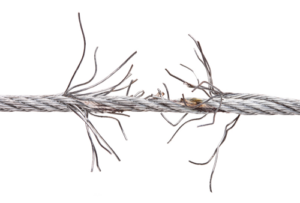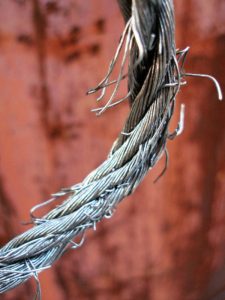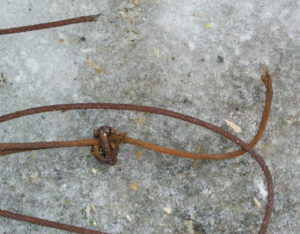When Should A Boat Lift Cable Be Replaced?
The proper time to replace a boat lift cable depends on a variety of circumstances:
- How well is it maintained?
- How often is it lubricated?
- What is used to lubricate the cables?
- Is the cable winding properly?
- Was the lift sized properly?
- Is there any visual damage to the cable?
- Are there frayed wires on the cable?
- Is it a galvanized cable or stainless steel?
- Is there corrosion on the cable?
What is the proper lift cable maintenance?
Lift cable replacement depends on a visual inspection of the lift cables to help determine when to replace them. It’s best to inspect it while it is on dry land in order to check all of the key points. Ideally, the lifting platform (or rack) should be in the lowered position. Of course, make sure the lift cable is not allowed to go slack.
Examine the vertical length of the cable for frayed wires especially near the winch. CAUTION – Always wear leather gloves when sliding your hands on the cable. To put it differently, a frayed wire can cause extensive, painful damage to unprotected hands.
The cable is made up of multiple strands of wire and multiple wraps are used to form the overall cable. Excessive fraying or corrosion near the winch is a top signal of damage.
Nothing lasts forever – even boat lift cables
There are two types of cable wear:
- Internal cable abrasion- This occurs whenever strands work against each other under load.
- External abrasion – This also occurs when the cable bends around the winch drum and rubs against the adjoining cable or drum.
How long a lift cable lasts depends on:
- How often it’s used;
- What type of cable it is; and
- The care it receives.
Every time a boat is raised or lowered over a winch drum there is internal wear on the cable. Each strand of wire in the winding is moving at a slightly different speed. Abrasion of the cable strands is the result. When you loose too many strands you lose a lot of strength.
What should be done?
Steel lift cables require a squirt or two of penetrating oil occasionally to reduce the internal friction on the strands and individual wires in the cable. This is particularly important on galvanized cables. Lubrication helps to preserve the galvanized coating and minimizes abrasion between strands. Grease should NEVER be used, as it traps moisture inside the strands. Do not saturate the cable and only use penetrating oil for best results.
Stainless steel lift cable will also benefit from a few squirts of penetrating oil. This should be done in Spring and again in Fall.
Strong indicators that a boat lift cable needs to be replaced:
- Excessive broken strands:
- Kinks:
- Deformities and
- Areas of heavy corrosion.
Corrosion
Galvanized cables that break tend to show signs of corrosion or rust. Usually this is located near the winch when the rack is in the lowered position. It also can be at the bottom of the cable where it is secured to the frame. Note: do not allow the main cable to go “slack” when lowering the rack.
A slight discoloration indicates that the protective galvanizing coating has been worn away. Concentrations of heavy rust indicate that the steel cable itself has lost considerable strength and should be replaced immediately.
Assuming the cable is well cared for, how long should it last?
Experts say that, to be safe, galvanized cable should be replaced every two years. All things being equal, stainless cable will last longer, up to twice as long.
A point often overlooked – internal abrasion or rust can be hidden and may not show visible damage on the cable. A boat lift cable like this may sometimes fail without prior warning. An improperly positioned boat, shocks from wave action (when bouncing on the lift rack or jamming the rack against the frame may send your boat into the water.
When in doubt, replace the cable; trying to squeeze another year out of a $75 cable isn’t worth the risk of dropping your boat or personal injury.
Remember
Pier & Waterfront Solutions (PWS) specializes in all ShoreMaster docks, lifts and accessories.
Located in the center of Door County at 7325 St Hwy 57, just south of Sturgeon Bay at the intersection of Idlewild Road. Our staff looks forward to serving all of your waterfront needs.
Found this article helpful? Go to “NEWS” on any page of our website for a complete list of articles meant to keep you informed on the latest product information and maintenance issues. Check out our “older entries” also.
The wide variety of articles on dock and boat lifts issues will answer many of your questions. PWS believes that an informed consumer makes better decisions.
Call Jerry at 920-493-4404 or Email Jerry@wisconsinpws.com for more information.
Coming Soon – “The PWS Store” on our website








